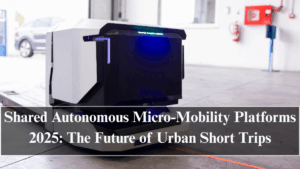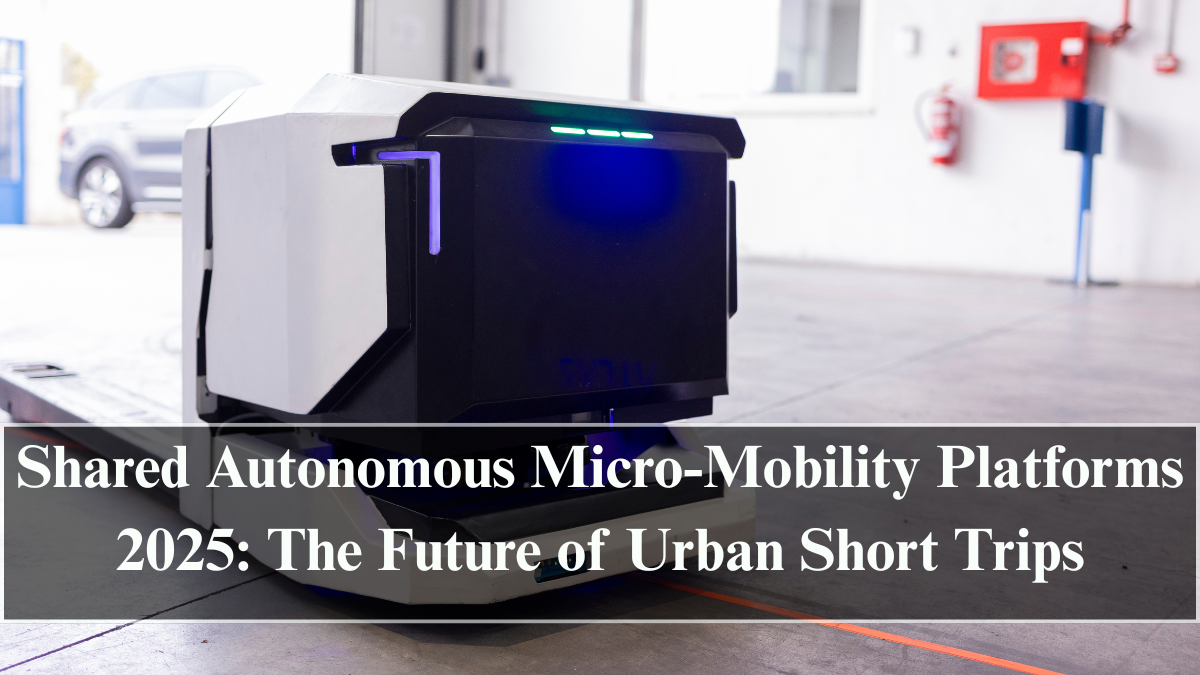Urban mobility in 2025 is undergoing a radical transformation. As cities grow denser and traffic congestion worsens, shared and autonomous micro-mobility platforms have emerged as a key solution to move people efficiently and sustainably. Shared Autonomous Micro-Mobility Platforms 2025 integrate AI, IoT, and robotics to manage fleets of self-driving e-scooters, robo-mopeds, and compact electric pods — redefining how short trips in cities are made.
What once seemed futuristic is now a common sight in major smart cities like Singapore, Tokyo, Amsterdam, and Bengaluru. Fleets of autonomous e-scooters glide seamlessly through city streets, repositioning themselves for pickup, returning to charging hubs automatically, and even navigating traffic independently. These AI-managed mobility systems are reducing carbon emissions, easing urban gridlock, and enabling last-mile transport that’s efficient, safe, and contactless.

The Rise of Robo-Scooters and Autonomous E-Mopeds
The global shift toward micro-mobility began with dockless e-scooters, but 2025 has taken it several steps further. Today’s robo-scooters are equipped with LIDAR sensors, 360° cameras, and GPS-based navigation systems that allow them to drive autonomously to designated locations. Instead of users searching for scooters, scooters now come to users — thanks to advanced AI fleet management.
Autonomous e-mopeds, meanwhile, are revolutionizing mid-range city commuting. They feature self-balancing technology, automated braking, and integrated safety sensors that monitor road conditions in real time. Combined with ride-sharing apps, these systems allow urban travelers to book quick, low-cost rides with unmatched convenience and minimal environmental impact.
How AI Manages Shared Micro-Mobility Fleets
Behind every autonomous micro-mobility platform is a complex AI-driven ecosystem that orchestrates vehicles across the city. Machine learning algorithms process data from GPS, sensors, and user demand patterns to predict where vehicles will be needed most.
For instance:
-
Fleet Rebalancing: AI dispatches idle scooters to high-demand zones automatically.
-
Energy Optimization: Vehicles drive themselves to nearby charging docks or swap batteries autonomously.
-
Predictive Maintenance: IoT sensors continuously monitor component health and alert operators before breakdowns occur.
-
Traffic Coordination: Real-time communication with city networks helps these vehicles avoid congestion or restricted areas.
This automation not only reduces human management costs but also ensures fleets remain available, charged, and safe 24/7 — making urban mobility smoother and more reliable.
Benefits for Cities and Commuters
The impact of Shared Autonomous Micro-Mobility Platforms 2025 extends beyond convenience. These intelligent systems offer tangible benefits for both city infrastructure and individual commuters:
-
Reduced Traffic Congestion: Smaller autonomous vehicles occupy less road space, easing pressure on urban roads.
-
Zero Emissions: All-electric fleets contribute to cleaner air and sustainability targets.
-
Affordable Last-Mile Connectivity: Micro-mobility fills the gap between public transit stops and final destinations.
-
Enhanced Accessibility: Autonomous platforms serve areas where large vehicles cannot operate, improving inclusivity.
-
Data-Driven Urban Planning: Aggregated travel data helps governments design better roads, bike lanes, and traffic systems.
By integrating these platforms with metro and bus networks, cities are creating multi-modal mobility systems that prioritize sustainability and efficiency.
Challenges in Implementation
Despite the promise, widespread deployment of autonomous micro-mobility still faces key challenges in 2025. Infrastructure readiness, regulatory approval, and safety validation remain ongoing hurdles. In many cities, local laws restrict self-driving vehicles in pedestrian zones, delaying large-scale rollout.
Cybersecurity is another pressing concern. As fleets communicate wirelessly and depend on real-time data exchange, vulnerabilities in cloud systems could expose them to potential hacking risks. Companies are countering this by implementing end-to-end encryption, edge processing, and AI-based anomaly detection to protect networks.
Battery management and weather resilience also remain critical factors — particularly in tropical or high-traffic environments where wear and tear is high.
The Future of Urban Short-Distance Travel
Looking ahead, Shared Autonomous Micro-Mobility Platforms 2025 represent the first step toward fully autonomous urban ecosystems. By 2030, experts predict that over 40% of last-mile travel in major metropolitan areas will be powered by AI-managed fleets. Integration with autonomous ride-hailing, electric buses, and V2X infrastructure will create seamless, low-cost transport grids accessible to everyone.
Future innovations are expected to include solar-powered charging hubs, AI traffic coordination systems, and subscription-based mobility plans allowing unlimited city travel for a monthly fee. These developments will further democratize transportation while drastically cutting emissions and travel time.
FAQs
What are shared autonomous micro-mobility platforms?
They are AI-powered systems that manage fleets of self-driving e-scooters, mopeds, or small EVs for public use in urban areas.
How do autonomous scooters and mopeds navigate safely?
They use LIDAR, GPS, and AI-based navigation to detect obstacles, follow lanes, and communicate with other vehicles and traffic systems.
What benefits do these platforms offer cities?
They reduce congestion, emissions, and operating costs while improving last-mile accessibility and urban air quality.
Are these vehicles available everywhere?
As of 2025, major cities in Asia, Europe, and North America are leading the rollout, with global expansion expected by 2030.
What’s the future of micro-mobility automation?
Future fleets will be fully integrated with smart city grids, powered by renewable energy, and available through subscription-based models.
Click here to know more.
